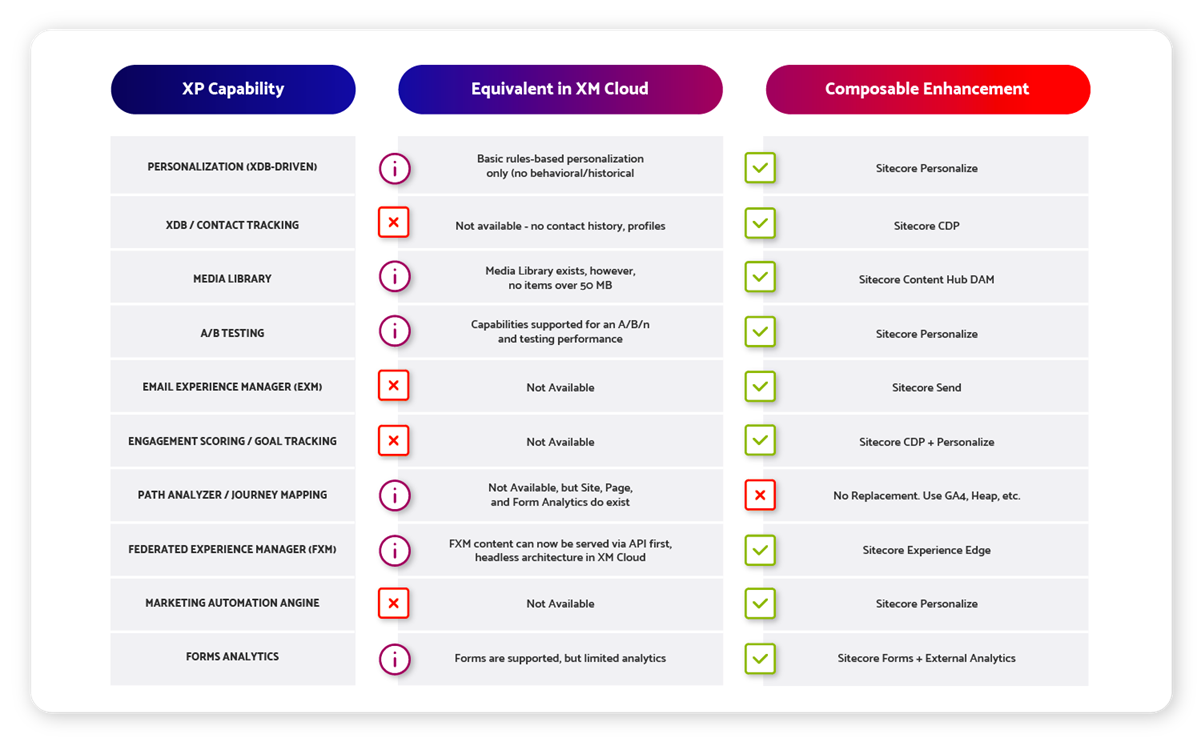Thinking About Sitecore XM Cloud? Here’s What Marketers Need to Know (and Why It’s Worth It)
written by Steve Sobenko
|May 2025
If you are currently using Sitecore XP, you may have heard about XM Cloud, Sitecore’s fully managed, cloud-based, SaaS platform. But what does that mean for your marketing team? And more importantly, why should you consider migrating to XM Cloud?
This guide explains everything you need to know in practical terms, without the tech jargon.
Why Organizations Are Moving to XM Cloud
Sitecore XP is the familiar platform that many teams have relied on for years. We've supported clients on XP for almost 20 years from Sitecore 5.2 to today on 10.4. It has served its purpose well but often requires ongoing maintenance, manual updates, and costly time consuming upgrades. XM Cloud is Sitecore’s new flagship. It's modern SaaS platform designed to remove the overhead of hosting, monitoring and running your own instance. It handles updates, hosting, and scalability behind the scenes so your team can focus on your delivering great experiences.
Key Benefits of XM Cloud:
- Always up to date with no manual upgrades
- Faster performance, better user experience, and access to Sitecore Pages, the new editing experience that rivals
- Adobe Experience Manager (AEM)
- Reduced costs and overhead by removing need for self hosting, self monitoring, DR solutions, backups, networking
- Infrastructure and teams needed for 24/7 critical support
- Streamlined tools for content authors and marketers
- Easier integration with modern analytics, CRM, and personalization platforms
- Built on a headless, composable model that is ready to plug and play with any extension or integration
Let's Talk ROI
Migrating to XM Cloud is more than an upgrade. It is a multi-year investment that delivers measurable returns by reducing your IT costs and maximizing your capability gains. The trend is the world is quickly moving toward cloud-based, SaaS platforms that simplify operations and overhead while staying up to date on modern features and capabilities. The move to XM Cloud is not just a technical project. It is a business decision that keeps your organization competitive, unlocks marketing performance, and reduces operational costs.
1. Lower maintenance costs With XM Cloud, you no longer need to budget for surprise upgrades, security patches, or infrastructure repairs. Support, hosting, and automatic updates are built in. Your IT team can shift focus from maintenance to innovation.
2. Faster campaign launches Quicker publishing cycles and less reliance on development resources mean your marketing team can bring campaigns to life faster, test more frequently, and adjust in real time.
3. Increased marketing team productivity Tools like Sitecore Pages and Component Builder allow non-technical users to manage content and even create new branded components. This improves workflow efficiency and reduces bottlenecks.
4. Omni-channel content reuse XM Cloud's headless setup allows content and layout data to be reused across web, mobile, social, marketplaces, and more. Update once, publish everywhere.
5. Composable architecture The platform is built to integrate easily with other modern tools. Choose the best-fit solution for forms, analytics, personalization, or DAM, and plug it in as needed.
6. Performance and SEO impact Using static site generation and server-side rendering improves Lighthouse scores. Better performance means better rankings and higher visibility in search results.
7. Predictable spend The SaaS pricing model removes the need for large, periodic upgrade projects. Costs become more consistent and easier to forecast. Those bi-yearly or yearly upgrades that cost thousands, sometimes hundreds of thousands, are no longer draining your budget.
8. Enhanced security By separating content from presentation, XM Cloud allows content to be hosted securely while user-facing experiences are served from high-performance global CDNs. This improves both security and scalability. XM Cloud separates your content from your presentation layer. That means your content repository is better protected, and user-facing experiences are delivered via secure global CDNs like Vercel or Netlify. This reduces risk and increases uptime.
Ready? What the Migration Looks Like
We typically follow a five-step approach that minimizes disruption and sets your team up for success.
Step 1: XM Cloud - Set up the New Environment
We prepare the XM Cloud foundation in the background while your existing site continues to operate.
Step 2: Custom Templates and Components
We update your templates and content blocks using modern UI frameworks and development tools that support headless architecture that are future proof. Your developers are no longer locked into a single language. XM Cloud supports development on any modern framework. NextJS, React, Vue, Angular? Absolutely. Bonus, this is the ideal time to align a visual redesign if one is already planned. Looking for a complete rebranding or refresh of your site? Perfect opportunity.
Step 3: Automated Deployments
We automate your Continuous Integration/ Continuous Deployment (CI/CD) pipelines to keep developers developing. Your backend is deployed to XM Cloud, and the front-end is hosted with a high-performance service like Vercel or Netlify. This makes your site faster, more secure, and easier to scale globally.
Step 4: Content Migration
Not too different than migrating content during a Sitecore upgrade, we move your pages, images, templates, and workflows into XM Cloud. We have automated scripting processes that are specifically built to optimize this.
Step 5: Launch and Support
Redirects, analytics, SEO, and final user testing are all completed before launch. Your team is trained, and we remain engaged for support as needed.
What Built in Capabilities Do I Lose by Leaving XP?
Technically nothing from a front-end capabilities perspective.
If you're doing a lot of customizations to XP, importing custom data, modifying the authoring experience, or doing a lot of overrides to Sitecore itself this may change a bit. If you're doing that, upgrades have likely become difficult to manage or some partners might have told you it's not possible (hint: it's probably possible).
We've come across a lot and been able to find alternative solutions to modifications to the XP platform to achieve the same business goals.
We've compiled a handy migration planner for some of the embedded features of XP that don't inherently exist in XM Cloud.

Final Thoughts
If your organization wants to reduce complexity, speed up delivery, and modernize digital experiences, XM Cloud is worth considering. This is not just a platform shift. It is a strategic investment in how your brand connects with customers.
Benefits Include:
- Shorter time-to-market for digital campaigns
- Lower ongoing IT and infrastructure costs
- Improved performance and SEO
- Easier scaling across regions and channels
- A more agile, future-proof marketing foundation
Ready to explore what a move to XM Cloud could look like for your team? We can help assess your readiness, plan your migration, and maximize the return on your investment.


